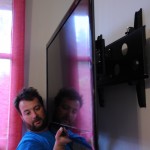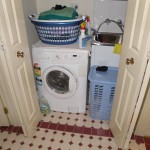Keeping your home safe means inspecting each room for potential hazards and eliminating them. Here are some common household dangers, room by room.
Kitchen
 Flammable items left on or near the stovetop. This includes dishtowels, pot holders, plastic wrap, paper bags, and pizza boxes.
Flammable items left on or near the stovetop. This includes dishtowels, pot holders, plastic wrap, paper bags, and pizza boxes.- Grease spills on the stovetop, on the bottoms of pans, and in the bottom of the oven. These are often left-over from previous cooking and forgotten.
- Forgetting to wash your hands after handling raw meat or eggs.
Bathroom
 Slippery surfaces including the bathtub, shower floor, and wet floors, all of which can lead to slip and fall.
Slippery surfaces including the bathtub, shower floor, and wet floors, all of which can lead to slip and fall.- Hot water that is too hot, causing scalds. Hot water heaters should be set to no more than 120F.
- Hidden poisons. Cosmetics, liquid soaps, shampoo, and perfume can be toxic if ingested by a child.
Living Room
 TVs and other furniture that are not properly anchored. A TV can tip over and kill or seriously injure a small child, and it happens more often than you might think.
TVs and other furniture that are not properly anchored. A TV can tip over and kill or seriously injure a small child, and it happens more often than you might think.- Overloaded power strips. Power strips make life easy and they can protect your electronics from a power surge, but when they are overloaded or the outlet they are plugged into becomes overloaded by their use, they become fire hazards.
- Unsecured rugs. An unsecured rug can quickly become a tripping hazard.
Laundry Room
 Lint build-up in the dryer can cause a fire. Clean the lint screen after each load.
Lint build-up in the dryer can cause a fire. Clean the lint screen after each load.- Washers and dryers can be deadly for children and pets if they get inside. Keep them locked, even when not in use. If yours do not have built-in locks you can purchase child safety locks for them.
- Laundry detergent, fabric softener, bleach and other cleaning supplies you keep in the laundry room can be poisonous if ingested, and some can cause blindness if they splash into your eyes or burns if they contact your skin. Keep lids on properly, store in a safe place out of the reach of children and not on a high shelf.















